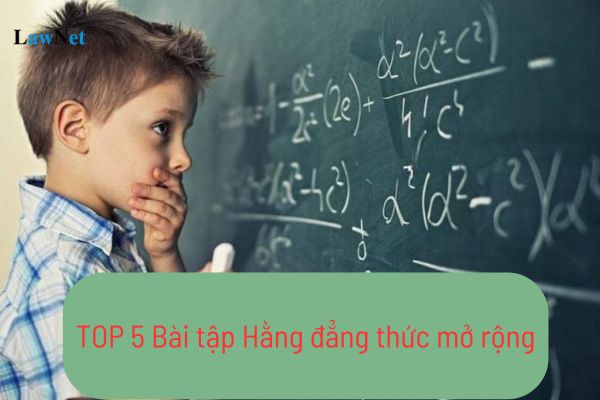Vietnam: What are the top 5 types of exercises on algebraic identities? Are algebraic identities included in the 8th-grade Mathematic program?
What are the top 5 types of exercises on algebraic identities in Vietnam?
Algebraic identities are mathematical formulas used to transform algebraic expressions into different forms, simplifying calculations and solving complex problems. They are built upon the 7 basic identities you learned in previous educational levels.
|
Top 5 types of exercises on algebraic identities: Direct Application of Identities: |
*Note: Information about the adjective is only for reference purposes./.
Are algebraic identities included in the 8th-grade Mathematic program in Vietnam?
Under Section 5 of the Annex of the General Education Program in Mathematics issued together with Circular 32/2018/TT-BGDDT on the requirements for 8th-grade Mathematics, the 7 memorable identities are included in the 8th-grade Mathematic program in Vietnam as follows:
Memorable identities are part of the algebra section.
In the algebraic expressions section, outcomes required after completing the lesson on Memorable Identities are:
- Recognize the concepts: identity, identity theorem.
- Describe the identities: square of a sum and difference; difference of squares; cube of a sum and difference; sum and difference of cubes.
- Apply the identities to factor polynomials in forms: direct application of identities; apply identities through grouping terms and factoring out a common factor.
Thus, the algebraic identities are included in the 8th-grade Mathematic program in Vietnam.

What are the top 5 types of exercises on algebraic identities in Vietnam? (Image from the Internet)
What are the education methods for the 8th-grade Mathematic program in Vietnam?
According to Section 6 of the General Education Program in Mathematics issued together with Circular 32/2018/TT-BGDDT, the general education program in Mathematics in general and the 8th-grade Mathematic program in particular will apply the following methods:
- The teaching approach in the 8th-grade Mathematic program must meet the following basic requirements:
+ Conform to students' cognitive progression (moving from concrete to abstract, from easy to difficult); not only emphasize the logical nature of mathematics but also pay attention to approaches based on student's experience and learning;
+ Adhere to the spirit of "learner-centered," actively engaging students, considering individual needs, cognitive abilities, and different learning styles; organize the learning process towards constructivism, where students participate in exploration, problem-solving, deduction;
+ Be flexible in the application of active teaching methods and techniques; skillfully combine and creatively apply traditional teaching methods and techniques; combine classroom teaching activities with practical experience, applying mathematical knowledge to real-world situations. Ensure a balanced, harmonious structure between core knowledge, applied knowledge, and other components.
+ Use and effectively implement the minimum teaching aids according to regulations for Math; consider using self-made teaching tools that suit the lesson content and student audience; strengthen the use of information technology and modern teaching aids;
- Orientations for methods to form and develop essential qualities and general competencies
+ Methods to form and develop essential qualities
Through organizing instructional activities, Mathematics contributes, along with other subjects and educational activities, to help students develop honesty, a love of labor, a sense of responsibility, and a consciousness of completing study tasks; foster confidence, interest in learning, a habit of reading, and consciousness to explore and discover science.
+ Methods to form and develop general competencies
+ Mathematics contributes to forming and developing self-control and self-learning capacity by training learners to choose objectives, make study plans, develop self-study skills, draw experience and adjust, to apply in various contexts while learning mathematical concepts, knowledge, and skills, as well as when practicing, exercising, or independently solving mathematics and addressing mathematically significant issues.
+ Mathematics contributes to forming and developing communication and cooperation skills through listening, understanding, reading comprehension, recording, and expressing mathematical information necessary in mathematical texts; by effectively using mathematical language combined with ordinary language to exchange, and present mathematical content, ideas, solutions interactively with others, while showing confidence, respect for interlocutors when describing, explaining mathematical content, ideas.
+ Mathematics contributes to forming and developing problem-solving and creativity by helping students recognize problematic situations; share the understanding of problems with others; propose, and choose methods, and processes to resolve problems, and know how to present solutions; evaluate solutions that have been implemented and generalize for similar problems.
- The teaching method for Mathematics contributes to forming and developing calculating capacity, language capacity, and other specific competencies. To be specific:
+ Mathematics, with its outstanding advantages, provides many opportunities to develop calculating capacity, shown in offering mathematical knowledge and practicing calculating and estimating skills, helping form and develop components of mathematical capacity (thinking and reasoning, modeling, problem-solving; communication, and using mathematical learning tools and means).
+ Mathematics contributes to developing language capacity through training reading comprehension, interpretation, analysis, and evaluation skills of mathematically significant situations, using mathematical language effectively combined with ordinary language to present, express mathematical content, ideas, solutions.
+ Mathematics contributes to developing informatics capacity through using information technology and communication tools as learning and self-study aids; creating an experiential learning environment.
+ Mathematics contributes to developing aesthetic competence by familiarizing students with the history of mathematics, biographies of mathematicians, and recognizing the beauty of Mathematics in the natural world.
Download for more details of the General Education Program in Mathematics issued together with Circular 32/2018/TT-BGDĐT.

